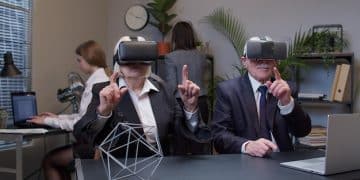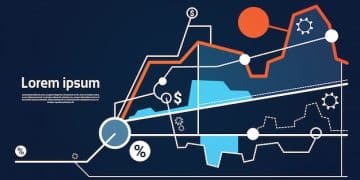Labor Market Dynamics: Impact of 3.7% Unemployment on Hiring

The current 3.7% unemployment rate signifies a tight labor market, compelling businesses to strategically adapt their hiring and retention initiatives to attract and keep skilled talent amidst fierce competition for high-quality candidates.
The landscape of the American workforce is in a constant state of flux, shaped by economic indicators and societal shifts. Currently, a 3.7% unemployment rate presents a unique challenge for businesses, dictating a need for nuanced and agile approaches to talent management and growth. This low unemployment figure, while generally indicative of a robust economy, complicates the hiring process, making it harder for companies to find and retain the high-quality employees they need to thrive. Understanding the intricacies of this dynamic is crucial for any organization aiming to maintain a competitive edge.
Understanding the 3.7% Unemployment Rate: A Macro Perspective
A 3.7% unemployment rate in the United States signals a labor market near full employment. This low figure suggests that most individuals who are willing and able to work have found employment. Economists often view such low rates as a positive indicator of economic health, reflecting strong consumer demand and business expansion. However, for employers, it translates into a highly competitive environment where skilled candidates are scarce and demand high compensation and benefits.
This tightness means the power balance shifts, giving job seekers more leverage. They can afford to be selective, choosing roles that offer not just good pay, but also career development, work-life balance, and a positive company culture. Businesses, in turn, are forced to reassess their value propositions, moving beyond just salary to differentiate themselves as employers of choice. The implications extend across industries, affecting everything from manufacturing to tech and services.
Historical Context and Economic Impact
To fully grasp the current situation, it’s important to consider historical unemployment trends. Periods of sustained low unemployment typically follow economic recoveries, where job growth outpaces population growth, gradually absorbing available labor. The current rate is not an anomaly but rather a continuation of patterns observed in strong economic cycles. The impact on wages is also significant; with fewer available workers, companies often have to increase salaries to attract and retain talent, which can contribute to wage inflation across the economy. This economic effect can be a double-edged sword, benefiting workers with higher pay but potentially increasing operational costs for businesses.
- Periods of low unemployment often correlate with economic expansion.
- Historically, tight labor markets lead to increased wage pressure.
- The current rate reflects sustained post-pandemic recovery and growth.
Understanding these broader economic forces allows businesses to anticipate market shifts and adjust their strategies proactively. It’s not just about reacting to the current numbers but also about building resilience for future fluctuations. The constant interplay between supply and demand in the labor market requires continuous monitoring and adaptation to ensure long-term stability and growth.
The 3.7% unemployment rate is a complex economic signal. While it reflects overall economic strength, it also creates significant operational challenges for businesses struggling to fill critical roles. Recognizing these dynamics is the first step toward developing effective hiring and retention strategies tailored to the realities of a tight labor market.
The Employer’s Dilemma: Challenges in Hiring and Talent Acquisition
For organizations operating in a market with 3.7% unemployment, the primary challenge is not a lack of jobs, but a shortage of qualified candidates. This scarcity extends across various sectors, making it difficult for businesses to simply post an opening and expect a flood of suitable applications. Recruiters now face intense competition for every promising candidate, often leading to protracted hiring timelines and increased recruitment costs.
The pressure is particularly acute for specialized roles and in industries experiencing rapid growth. Companies are finding that traditional hiring methods are no longer sufficient. They must become more proactive, creative, and efficient in their talent acquisition efforts, often adopting new technologies and strategies to connect with potential employees. This shift marks a significant departure from an employer-driven market to one where job seekers hold considerable power.
Rising Recruitment Costs and Time-to-Hire
One direct consequence of a tight labor market is the escalation of recruitment costs. Businesses are spending more on advertising, headhunters, and increasingly competitive salary packages to lure candidates away from existing roles or competing offers. The time it takes to fill a position, known as “time-to-hire,” has also significantly increased, leading to productivity gaps and potential delays in project completion.
- Increased expenditure on job boards and recruitment agencies.
- Higher salaries and benefits offered to attract top talent.
- Longer hiring cycles impacting project timelines and team efficacy.
Moreover, the risk of mis-hires or quick turnovers increases if companies rush to fill positions. This adds another layer of cost and disruption, emphasizing the importance of thorough vetting even under pressure. The strategic implications of these challenges are profound, affecting not just HR departments but also operational efficiency and ultimately, profitability.
In this environment, companies must prioritize employer branding and candidate experience. A strong reputation as a desirable workplace can significantly reduce recruitment hurdles, making it easier to attract passive candidates. Investing in robust talent acquisition technology and internal referral programs can also provide a competitive edge, reducing reliance on external, more costly channels.
Retention in a Competitive Landscape: Keeping Your Best People
In a labor market where talent is scarce, retaining existing employees becomes as critical as, if not more critical than, attracting new ones. The 3.7% unemployment rate means that your current employees are highly attractive to other companies. If they are not engaged, compensated fairly, and offered growth opportunities, they might be easily swayed by competing offers, leading to costly turnover.
Employee retention strategies in this environment must be holistic, addressing various aspects of the employee experience. It’s no longer enough to offer a competitive salary; employees are looking for a comprehensive package that includes professional development, work-life balance, a supportive culture, and a sense of purpose. This shift demands a proactive approach from leadership, focusing on what truly motivates and satisfies their workforce.
Beyond Compensation: The Full Spectrum of Employee Value
While competitive compensation remains fundamental, it is rarely the sole factor in retention. Employees often leave jobs due to issues related to management, lack of growth opportunities, poor company culture, or insufficient work-life balance. Therefore, modern retention strategies must encompass a broader range of initiatives aimed at enhancing the overall employee value proposition.
For instance, companies are increasingly investing in learning and development programs, allowing employees to upskill and reskill, which not only benefits the individual but also strengthens the organization’s capabilities. Flexible work arrangements, comprehensive wellness programs, and a focus on diversity, equity, and inclusion (DEI) are also becoming standard expectations that contribute significantly to employee satisfaction and loyalty. These elements combine to create an environment where employees feel valued, supported, and motivated to stay.

Effective retention also relies heavily on strong leadership and regular feedback mechanisms. Managers play a pivotal role in employee engagement, and their ability to mentor, motivate, and address concerns can make a significant difference. Regular one-on-one meetings, performance reviews that focus on development, and open channels for communication ensure that employees feel heard and understood. Ultimately, a strong retention strategy is built on a foundation of mutual respect and continuous investment in human capital.
Strategic Adaptations: What Companies Are Doing Differently
To navigate the challenges posed by a 3.7% unemployment rate, businesses are implementing a range of strategic adaptations. These changes span from recruitment methodologies to internal development programs, reflecting a fundamental shift in how organizations approach talent. The goal is no longer just to fill a vacant position, but to build a resilient, skilled workforce capable of sustaining growth in a dynamic market.
Many companies are moving away from traditional, reactive hiring to more proactive and continuous talent sourcing. This involves building talent pipelines, engaging with potential candidates long before a position opens, and fostering relationships within professional communities. The emphasis is on long-term HR planning rather than short-term vacancy filling.
Leveraging Technology and Data in Talent Acquisition
Technology is playing an increasingly vital role in helping companies streamline their hiring processes and gain a competitive edge. Applicant Tracking Systems (ATS) are used to manage large volumes of applications, while AI-powered tools can help with resume screening, candidate matching, and even preliminary interviews. Data analytics, on the other hand, provides insights into recruitment effectiveness, helping HR teams optimize their strategies and identify bottlenecks.
- Automated screening and candidate matching with AI tools.
- Data analytics for optimizing recruitment channels and ad spend.
- Enhanced candidate experience through digital platforms.
Beyond external recruitment, technology also supports internal mobility and training. Learning Management Systems (LMS) provide platforms for continuous employee development, while internal talent marketplaces enable employees to find new roles within the organization, fostering retention and maximizing internal skills. This technological integration transforms HR from a purely administrative function into a strategic partner critical for business success.
Another significant adaptation is the focus on employer branding. Companies are investing in showcasing their unique culture, values, and benefits through social media, career websites, and employee testimonials. A strong employer brand can significantly enhance attractiveness to passive candidates, who might not be actively looking for a job but are open to better opportunities. This proactive approach to image management is crucial in a market where candidates have many options.
The Great Reshuffle: Impact on Employee Expectations
The “Great Reshuffle,” a term often used to describe the ongoing shifts in the labor market, is intrinsically linked to low unemployment rates. With abundant job opportunities, employees have become more discerning and empowered. Their expectations have evolved beyond traditional notions of employment, leading to significant changes in their priorities and demands from employers.
This phenomenon means that companies are not just competing for talent but also for mindshare and loyalty. Employees are increasingly seeking roles that align with their personal values, offer flexibility, provide meaningful work, and contribute to their overall well-being. The traditional employer-employee contract has been renegotiated, with greater emphasis placed on mutual benefit and employee empowerment.
Work-Life Balance and Flexibility as Core Demands
Perhaps one of the most prominent shifts in employee expectations is the demand for work-life balance and flexibility. The pandemic accelerated the adoption of remote and hybrid work models, and many employees are now unwilling to return to rigid in-office schedules. Companies that offer greater autonomy over work arrangements, flexible hours, and supportive work environments are more likely to attract and retain talent.

This includes robust wellness programs, mental health support, and policies that genuinely promote a healthy equilibrium between professional and personal life. Employers who fail to adapt to these evolving expectations risk losing their best people to organizations that offer a more progressive and human-centric approach to work. The new normal dictates that flexibility is not a perk but a fundamental expectation.
Furthermore, employees are placing a higher value on career development and personal growth. They want to know there are opportunities to learn new skills, take on new responsibilities, and advance within the organization. Companies that invest in continuous learning, mentorship programs, and clear career paths are more likely to foster loyalty and reduce turnover, as employees see a clear future for themselves within the company’s structure.
Future Outlook and Preparing for Continued Tightness
Forecasting the future of the labor market is challenging, but current indicators suggest that the 3.7% unemployment rate, or similar low figures, may persist for some time. Demographic trends, ongoing economic growth, and the pace of technological change all contribute to a dynamic environment where talent scarcity remains a core concern for businesses. Therefore, strategic foresight and proactive planning are essential for long-term success.
Companies should assume that talent acquisition and retention will continue to be strategic priorities. This means embedding these considerations into overall business strategy, rather than treating them as isolated HR functions. Adapting to this new reality involves continuous innovation in HR practices, investment in human capital, and a commitment to creating an attractive and sustainable workplace.
Building a Resilient Workforce for Tomorrow
Building a resilient workforce requires a multi-faceted approach. It starts with a strong focus on internal talent development, ensuring that current employees have the skills needed for future roles. This reduces reliance on external hiring and fosters a culture of continuous learning. Apprenticeships, cross-training programs, and leadership development initiatives are crucial components of this strategy.
Companies also need to embrace diversity, equity, and inclusion not just as a matter of compliance, but as a strategic advantage. A diverse workforce brings varied perspectives, enhances innovation, and expands the talent pool, making it easier to find candidates in a tight market. Creating an inclusive environment where all employees feel valued and respected is key to leveraging this diversity effectively.
Finally, maintaining an agile and adaptable organizational structure is paramount. The ability to pivot quickly to changing market conditions, adopt new technologies, and embrace flexible work models will differentiate successful companies. This forward-looking approach ensures that businesses are not just surviving the tight labor market but thriving within it, positioning themselves for sustainable growth and innovation.
The strategies outlined here represent a significant shift in business priorities. From reactive hiring to proactive talent management, companies are transforming their approach to human capital. Those that embrace these changes will be well-positioned to navigate the current and future labor market dynamics, securing the talent necessary for sustained success.
The Role of Culture in Attracting and Retaining Talent
In a labor market characterized by a 3.7% unemployment rate, company culture has emerged as a crucial differentiator for attracting and retaining talent. Beyond competitive salaries and benefits, candidates are increasingly scrutinizing the work environment, seeking places where they feel valued, supported, and aligned with organizational values. A positive and inclusive culture can transform an employer into a magnet for top-tier talent, even when competition is fierce.
Culture is not merely about perks or superficial gestures; it’s about the fundamental way an organization operates, makes decisions, and treats its people. It encompasses leadership styles, communication practices, opportunities for growth, and how the company contributes to society. In a tight market, employees are empowered to choose environments that resonate with their personal and professional aspirations.
cultivating Psychological Safety and Belonging
A key aspect of a compelling company culture is the presence of psychological safety. This refers to an environment where employees feel secure enough to express ideas, ask questions, admit mistakes, and take calculated risks without fear of negative repercussions. When psychological safety is present, it fosters innovation, encourages open communication, and promotes candid feedback, all of which are essential for growth and problem-solving.
- Encouraging open dialogue and constructive feedback.
- Promoting a non-punitive approach to learning from errors.
- Ensuring that diverse voices are heard and respected.
Related to psychological safety is the sense of belonging. Employees want to feel like they are part of a community, where their contributions are recognized and they are valued for who they are. Initiatives that promote diversity, equity, and inclusion are crucial in this regard, as they ensure that employees from all backgrounds feel welcomed and integrated into the organizational fabric. When employees feel they belong, they are more likely to be engaged, productive, and committed to the company’s success.
Furthermore, an attractive culture is often characterized by strong leadership that leads by example. Leaders who are transparent, empathetic, and committed to their employees’ well-being inspire trust and loyalty. They foster an environment where employees feel empowered to grow, take ownership of their work, and contribute to the company’s broader mission. Ultimately, a strong, positive culture is not just a strategic advantage in a tight labor market, but a fundamental pillar of long-term organizational health and resilience.
| Key Point | Brief Description |
|---|---|
| 📊 Tight Labor Market | 3.7% unemployment signifies intense competition for skilled candidates. |
| 💲 Rising Costs | Increased expenses in recruitment and competitive compensation packages. |
| 🔄 Retention Focus | Beyond salary, focus on culture, development, and work-life balance. |
| 💡 Strategic Adaptation | Leveraging technology, data, and employer branding for talent acquisition. |
Frequently Asked Questions About Labor Market Dynamics
▼
A 3.7% unemployment rate indicates a very tight labor market. For employers, this means fewer available candidates, increased competition for talent, longer hiring times, and potential pressure to offer higher compensation and more attractive benefits to attract and retain skilled workers.
▼
In a tight labor market, employees have more options and are more likely to seek new opportunities if they feel undervalued or are dissatisfied. This increases the risk of turnover, compelling companies to prioritize retention strategies such as competitive pay, professional development, and a positive work environment.
▼
Businesses are adopting proactive strategies like strengthening employer branding, leveraging recruitment technology (AI, ATS), focusing on internal talent development, offering flexible work arrangements, and cultivating robust referral programs to find and secure desired talent.
▼
Economists have varying perspectives on the sustainability of very low unemployment rates. While some factors like demographic shifts could maintain tightness, economic fluctuations and technological advancements can also influence future trends. Businesses should prepare for continued competition for talent.
▼
With abundant job options, employees prioritize workplaces that offer psychological safety, a sense of belonging, and alignment with their values. A strong, inclusive company culture differentiates employers and significantly enhances their ability to attract, engage, and retain top talent in a competitive market.
Conclusion
The current 3.7% unemployment rate in the US underscores a powerful truth: the labor market is firmly in the hands of talent. For businesses, this translates into an imperative to strategically rethink and adapt their approaches to hiring and retention. From leveraging advanced technology and data analytics to fostering a nurturing company culture and offering flexible work arrangements, the most successful organizations are those that proactively address the evolving expectations of their workforce. Navigating this tight market effectively isn’t merely about filling vacancies; it’s about building a resilient, engaged, and highly skilled team capable of driving sustained growth and innovation, ultimately shaping the future of the American economy.





